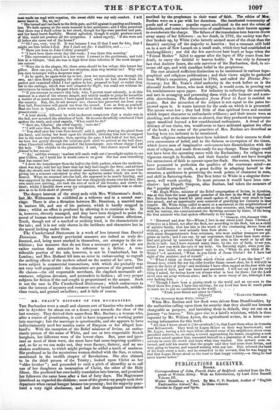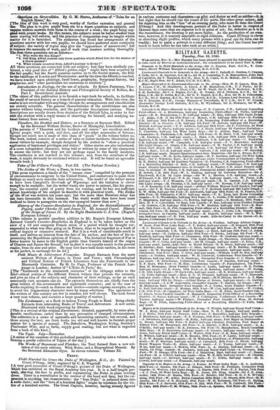PUBLICATIONS RECEIVED.
BOOKS.
Correspondence of John, Fourth Duke of Bedford: selected from the Ori- ginals at Woburn Abbey. With an Introduction, by Lord John Bowel Volume III. Walter Hamilton • a Novel. By Mrs. C. D. Burdett, Author of "English Fashionables Abroad," &c. In three volumes.
Nozrani in Egypt and Syria.
Questions on Generalities. By G. M. Sterne, Authoress of "Tales for an English Home," &c.
[The idea of this work is very good, worthy of further extension and general use. The plan is to give pupils from six to a dozen questions on subjects, and require written answers from them in the course of a week; the pupil being sup- plied with proper books. By this means, the subjects must be better studied than mere reading will enforce, and the practice of composition may be taught whilst matter for it is furnished. The authoress has found her arrangement of the questions answer with her own pupils; we should have preferred more continuity of subject: the variety of topics may give the "appearance of amusement," but it imposes the necessity of work, and of work that masters nothing thoroughly. The &rut three questions are as follows- " 1. Who were the Sea Kings?
"2. Did King Alfred possess only those qualities which fitted him for the station of a brave general? "3. What events occurred from Alfred's journey to Rome?"
All these questions are connected with one subject: bad they been similarly cen- t* fair pu ; but the fourth question carries us to the feudal system, the fifth tinued,bamvur good idea of " Alfred's golden reign" might have been acquired by totba: ings of London and Westminster; and by the time the fiftieth is reached, wabave touched upon philologer, fossil bones, geography, Scriptural history, the psqphecies, and " other particulars too numerous to mention."]
Introduction to Zoology, for the use of schools. By Robert Patterson, Vice- ' President of the Natural History and Philosophical Society of Belfast, &c. Part L Invertebrate Animals.
[The object of this publication is to furnish a text-book for schools, to facilitate the study .of natural history as a branch of general education. With this view, the reader is not overloaded with anything; though the arrangements and classification are strictly scientific. The general characteristics of the subdivisions are also precise without being overladen, and the particular descriptions carious. These descriptions are mostly drawn from denizens of the British Isles, in order to fur- nish the student with a ready means of observing for himself, and studying na- tural history from nature.]
Theodore, his Brother and Sisters; or a Summer at Seymour Hall. Edited
by, the Reverend William Nevins, Rector of Miningsby, Lincolnshire. [The parents of " Theodore and his brothers and sisters " are excellent and re- rigious people, with a park, and deer, and all the other accessories of fortune; though not much use is made of this class of " goods " in the volume before us. The mark, indeed, consists of a series of tales or rather incidents illustrating the moral virtues by example, though designed by the author to "show a practical application of baptismal privileges and duties." Other stories are also introduced, of a more independent character, being told or written by some of the characters to amuse the circle; but they are not perhaps equal to the family incidents. The conclusion is not reached in this volume; and, from the structure of the work, it might obviously be continued without end. It will be found an agreeable juvenile book.]
Tales of the O'Hara Family. Part HL (The Parlanr Novelist.) The Exiles of the West; a Poem, in two cantos.
[This poem represents a family of the " uneasy class " compelled by the pressure of circumstances to emigrate to the United States, and endeavours to paint their feelings as much sato describe their adventures. The model of the writer seems to have been Campbell's Gertrude of Wyoming: and the imitation is clever tweet to be readable; but the writer wants the power to extract, like his proto- type, the essential spirit of poetry from his reading, and be has not sufficient actual knowledge of his subject to describe it with practical truth. The Eagles of the West was written ten Tears ago; but the more than Horatian delay has not been favourable in this instance. The world would then have been more inclined to listen to panegyrics on the star-spangled banner than now.] History of the Counter-Revolution in England, for the Reestablishment of Popery, under Charles II. and James II. By Armand Carrel. History of the Reign of James II. By the Right Honourable C. J. Fox. (Bogner:3 European Library.) [This volume is another excellent addition to Mr. Bogue's European Library. Amend Carrel's Counter-Revolution in England is to be taken rather as the view of a vif and energetic French mind, of a period which he thought cor- responded to what was then going on in France, than to be regarded as a work of critical inquiry or extensive research. But it is a work of considerable merit in itself, and derives an interest from the fate of its author and the fact of his re- presenting the Republican opinions of France. The historical fragment of Fox is better known by name to the English public than Carrel's history of the reigns of Charles and James the Second; but infect it was equally scarce to the general reader, from its size and price. He may now have both these rarities, in his room or his pocket, in exchange for 3s. 6d.]
Petit Muses de Litterature Fratagaise. Elegant Extracts from the most eminent Writers of France, in Prose and Verse ; with Chronological and Critical Notices of French Literature from the Fourteenth to the Nineteenth Centuries. By M. Le Page, Professor of the French Lan- guage in London; Author of "L'Echo de Paris," &c.
[{The "fourteenth to the nineteenth centuries" of the titlepage refers to the brief critical notices of the different French writers that .preeede the extracts, and give an idea of the subjects and character of their writings, so far as such necessarily curt accounts can do. The extracts themselves are chiefly from the great writers of the seventeenth and eighteenth centuries; and in the case of works requiring it-such as dramas and stories-contain copious examples, so as to avoid the fragmentary character worn by many selections. The specimens of the writers of this century are few in number, but well chosen. The book forms a very neat volume, and contains a large quantity of matter.]
The .Eacite.ntssi; or a Book to induce Young People to Read. Being chiefly Extracts from interesting Books of Travel and Adventure. A new series. Illustrated with wood-engraving by Absolon.
[This is a revival of the original Excitement; dictated, apparently, by some plea- surable recollections, rather than by any perception of changed circumstances. The collection is a series of agreeable and interesting extracts; but several, and those among the best, are from books too old and well known to furnish proper matter for a species of annual. The Subaltern, Washington Irving, Southey's Peninsular War, and so forth, supply good reading, but not what is expected from a book of this kind.]
The Topic. July-November. [Aleeries of the numbers of this periodical pamphlet, bound up into a volume, and tmmieg a goodly collection of Topics of the day.] The Works of Beaumont and Fletcher; the Text formed from a new col- lation of the early editions. With Notes, and a Biographical Memoir. By the Reverend Alexander Dyce. In eleven volumes. Volume XL Parorr.
Field-Marshal his Grace the Duke of Wellington, K.G., 4-c. Painted by Count D'Orsay, 1846; engraved by C. E. Wagstaff: EA very good mezzotint of Count D'Orsay's picture of the Duke of Wellington, which was exhibited at the Royal Academy this year. It is a half-length por- trait. sho.ving the face in profile, and representing the Doke in plain evening dress. There is a resemblance in the contour of the head and face, but the ex- pression is anything but characteristic: the "Iron Duke" is softened down into a satin duke; and the " hero of a hundred fights " might be mistaken for the vic- tim of a hundred soirees. The Great Captain, however, having alrearly,figured in various costumes and characters-as pilot and doctor as well as soldier-it ie but right that he should ran the round of his parts, like other great actors; and for depicting him as the " lion " of an evening party, who more fit than the Count D'Orsay? And this drawingroom portrait of the Duke is better in respect of likeness than some that are superior to it in point of art; for, defective as it is in the resemblance, the drawing is yet more faulty. As the production of an ama teur, however, it is scarcely amenable to rigid critieiem. Count D'Orsay is clever at sketching slight profiles, which many persons with a good eye for form can do readily; but to pgmt a portrait is a very different thing; and the Count has yet much to learn before he can take rank as an artist.]



























 Previous page
Previous page